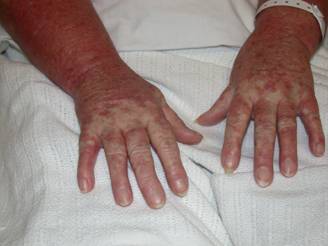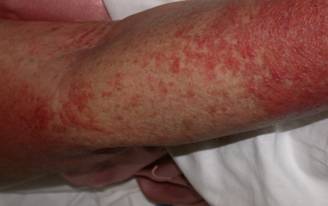MRSA infection of a Primary TKA following an infected IV cannula site complicated by Stevens-Johnson Syndrome- A Case Report
SKM Annamalai, SS Raju and VG Langkamer
Cite this article as: BJMP 2011;4(2):a415
|
|
Abstract We present here a 63 year old lady who had a primary total knee arthroplasty( TKA) for osteoarthritis of knee. She developed methicillin resistant staphylococcus aureus( MRSA )infection of the primary prosthesis following an intravenous(IV) cannula site infection with MRSA bacteraemia. This was complicated by Stevens-Johnson syndrome following vancomycin therapy for the infection, which was confirmed by clinical features including typical skin rashes and skin biopsy. She was treated with alternative antibiotics and was referred to a specialist orthopaedic unit where she had a two- stage revision. In retrospect, the infection could have been avoided if the IV cannula was not left in for so long. She also unfortunately had an adverse reaction to the vancomycin which complicated the situation, making management difficult. A team consisting of orthopaedic surgeons, microbiologists, dermatologists and physiotherapists was essential for successful management of this difficult and complicated situation. Abbreviations: MRSA (methicillin resistant staphylococcus aureus), IV( intravenous), TKA (total knee arthroplasty), DM( diabetes mellitus) |
Introduction
Infection of a prosthetic total knee joint is a serious complication1 and should be diagnosed promptly2 and treated aggressively. We present an interesting case of MRSA infection of a primary total knee replacement following an IV cannula infection leading to bacteremia and subsequent infection of the knee prosthesis, complicated by stevens- Johnson syndrome .
There were many challenging issue which are outlined including diagnosis and management.
Case Report
A 63-year- old lady had an elective total knee arthroplasty for severe osteoarthritis of the knee. She had a background history of well-controlled type 2 diabetes mellitus and was on warfarin for a previous pulmanory embolism. As per the hospital protocol her warfarin was stopped before surgery until her INR was <1.5 and she was heparinised with a view of
warfarinizing after the surgery. She had an uneventful knee arthoplasty, but unfortunately one of her IV cannula site became cellulitic. She was empirically started on oral flucloxacillin after taking blood cultures and sending the cannula tip for microscopic culture and sensitivity (which is routinely done has hospital protocol for infected cannula sites).
Surprisingly the tip grew MRSA and also had MRSA bacteraemia. She became systemically unwell and septic, and was treated aggressively with parentral vancomycin for MRSA bacteraemia. She had a transeosphageal echocardiogram to rule out cardiac vegetation. She gradually improved but developed typical papular rashes over her palm, dorsum of hand, extensor surface of arm and forearm and trunk and buccal mucosa (Fig 1 and 2) .

Fig 1: Rash over the dorsum hands

Fig 2: Rash over the extensor aspects of forearm
She had a severe allergic reaction to vancomycin and the skin biopsy of the lesion confirmed that she had developed Stevens-Johnson syndrome. An alternative antibiotic was started following discussion with the specialist bone infection unit. She gradually improved over the next few weeks without any problem in her prosthetic replaced knee. At about 6 weeks post- operatively she developed severe pain and hot swelling of her replaced knee with decrease range of motion. Her inflammatory markers were markedly raised and the knee aspirate confirmed MRSA infection of the total knee replacement. She was referred to a specialist bone infection unit due to the complexity of the case, where she successfully underwent two- stage revision.
Discussion
Infection of a Knee replacement is a serious complication that requires significant hospital-based recourse for successful management3. The rate of infection of a primary knee replacement varies from 0.5- 12%1. Rheumatoid arthritis , previous surgery , diabetes mellitus are all associated with an increased risk of infection 4. Although there is no absolute diagnostic test for peri-prosthetic infection2 , a high index of clinical suspicion is essential. There has been a case report on MRSA cervical epidural abscess following IV cannulation 5, but to the best of our knowledge there has been no previous report of MRSA- infected knee arthroplasty following complications of IV cannulation. Stevens-Johnson syndrome involves rare but severe cutaneous adverse reactions related to a variety of medications including antibiotics6. Parenteral vancomycin is the first line treatment for MRSA bacteraemia. It is recognised that vancomycin is indicated in inducing Stevens -Johnson syndrome, mortalitiy being 30-100%7. It is vital that Stevens- Johnson syndrome is recognised early so that offending agents are stopped and supportive treatment commenced. Early dermatological consultation, skin biopsy and direct immunofluorescence7 are essential to confirm diagnosis so that effective treatment can be instituted.The diagnosis and management of this serious complication is complex and requires considerable recourse allocation by the patient, the hospital, the infectious disease specialist, and the orthopaedic surgeon1,5.
|
Competing Interests None declared Author Details SKM Annamalai, MBBS MRCS, Orthopaedic Registrar, Peterborough City Hospital, UK SS Raju, F2 Trainee, Western General Hospital Western Super Mare, UK VG Langkamer, Consultant Orthopaedic Surgeon, Western General Hospital Weston Super Mare, UK CORRESPONDENCE: SKM Annamalai, MBBS MRCS, 2, Boulton Court, Oadby, Leicester, LE2 4XA Email: sureshkumar.annamalai@gmail.com |
References
- Blom AW, Brown J, Taylor AH, Pattison G, Whitehouse S, Bannister GC. Infection after total knee arthroplasty. J Bone Joint surgery Br 2004 Jul;86(5):688-91.
- Elie Ghanem et al. Cell Count and Differential of the Aspirated fluid in the Diagnosis of the Infection at the Site of Total Knee Arthroplasty. J Bone Joint Surg Am. 2008;09: 1637-43.
- Buechel F F, Femino FP, D’Alessio J. Primary Exchange Revision Arthroplasty for Infected Total Knee Arthroplasty: A Long-Term study The Americal journal Of Orthopaedics .2004;April.190-98.
- Bengtson S, Knutson K. The infected Knee arthoplasty. A 6 year follow-up of 357 cases. Acta Orthop Scand 1991 Aug;62(4):310-11.
- Burgess CM, Wolverson AS, Dale MT.Cervical epidural abscess: a rare complication of intravenous cannulation. Anaesthesia. 2005 Jun;60(6):605-8.
- Mockenhaupt-Maja et al. Stevens-Johnson syndrome and toxic epidermal necrolysis: assessment of medication risks with emphasis on recently marketed drugs. The Euro SCAR- study: J-Invest- Dermatol, Jan2008, vol128, no. 1, p 35-44.
- Jones DH, Todd M, Craig TJ. Early diagnosis is key in vancomycin-induced linear IgA bullous dermatosis and stevens- Johnson syndrome. J Am Osteopath Assoc. 2004 Apr;10494):157-63

The above article is licensed under a Creative Commons Attribution-NonCommercial-NoDerivatives 4.0 International License.




